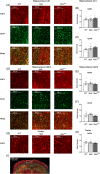Learning, memory and blood-brain barrier pathology in Duchenne muscular dystrophy mice lacking Dp427, or Dp427 and Dp140
- PMID: 38837620
- PMCID: PMC11151035
- DOI: 10.1111/gbb.12895
Learning, memory and blood-brain barrier pathology in Duchenne muscular dystrophy mice lacking Dp427, or Dp427 and Dp140
Abstract
Duchenne muscular dystrophy is a severe neuromuscular disorder that is caused by mutations in the DMD gene, resulting in a disruption of dystrophin production. Next to dystrophin expression in the muscle, different isoforms of the protein are also expressed in the brain and lack of these isoforms leads to cognitive and behavioral deficits in patients. It remains unclear how the loss of the shorter dystrophin isoform Dp140 affects these processes. Using a variety of behavioral tests, we found that mdx and mdx4cv mice (which lack Dp427 or Dp427 + Dp140, respectively) exhibit similar deficits in working memory, movement patterns and blood-brain barrier integrity. Neither model showed deficits in spatial learning and memory, learning flexibility, anxiety or spontaneous behavior, nor did we observe differences in aquaporin 4 and glial fibrillary acidic protein. These results indicate that in contrast to Dp427, Dp140 does not play a crucial role in processes of learning, memory and spontaneous behavior.
Keywords: cognition; dystrophin; neuromuscular disease; spatial learning; spontaneous behavior.
© 2024 The Authors. Genes, Brain and Behavior published by International Behavioural and Neural Genetics Society and John Wiley & Sons Ltd.
Conflict of interest statement
None related to this work. For full transparency, AAR discloses being employed by LUMC, which has patents on exon skipping technology, some of which has been licensed to BioMarin and subsequently sublicensed to Sarepta. As co‐inventor of some of these patents AAR is entitled to a share of royalties. AAR further discloses being ad hoc consultant for PTC Therapeutics, Sarepta Therapeutics, Regenxbio, Alpha Anomeric, Lilly BioMarin Pharmaceuticals Inc., Eisai, Entrada, Takeda, Splicesense, Galapagos, MitoRx and Astra Zeneca. Past ad hoc consulting has occurred for: CRISPR Therapeutics, Summit PLC, Audentes Santhera, Bridge Bio, Global Guidepoint and GLG consultancy, Grunenthal, Wave and BioClinica. AAR also reports having been a member of the Duchenne Network Steering Committee (BioMarin) and being a member of the scientific advisory boards of Eisai, hybridize therapeutics, silence therapeutics, Sarepta therapeutics. Past SAB memberships: ProQR, Philae Pharmaceuticals. Remuneration for these activities is paid to LUMC. LUMC also received speaker honoraria from PTC Therapeutics, Alnylam Netherlands, Pfizer and BioMarin Pharmaceuticals and funding for contract research from Italfarmaco, Sapreme, Eisai, Galapagos, Synnaffix and Alpha Anomeric. Project funding is received from Sarepta Therapeutics and Entrada.
Figures







Similar articles
-
Investigating the role of dystrophin isoform deficiency in motor function in Duchenne muscular dystrophy.J Cachexia Sarcopenia Muscle. 2022 Apr;13(2):1360-1372. doi: 10.1002/jcsm.12914. Epub 2022 Jan 26. J Cachexia Sarcopenia Muscle. 2022. PMID: 35083887 Free PMC article.
-
Cognitive dysfunction in the dystrophin-deficient mouse model of Duchenne muscular dystrophy: A reappraisal from sensory to executive processes.Neurobiol Learn Mem. 2015 Oct;124:111-22. doi: 10.1016/j.nlm.2015.07.006. Epub 2015 Jul 17. Neurobiol Learn Mem. 2015. PMID: 26190833
-
Impact of distinct dystrophin gene mutations on behavioral phenotypes of Duchenne muscular dystrophy.Dis Model Mech. 2024 Dec 1;17(12):dmm050707. doi: 10.1242/dmm.050707. Epub 2024 Dec 24. Dis Model Mech. 2024. PMID: 39718030 Free PMC article.
-
Brain function in Duchenne muscular dystrophy.Brain. 2002 Jan;125(Pt 1):4-13. doi: 10.1093/brain/awf012. Brain. 2002. PMID: 11834588 Review.
-
Combining genetics, neuropsychology and neuroimaging to improve understanding of brain involvement in Duchenne muscular dystrophy - a narrative review.Neuromuscul Disord. 2020 Jun;30(6):437-442. doi: 10.1016/j.nmd.2020.05.001. Epub 2020 May 16. Neuromuscul Disord. 2020. PMID: 32522501 Review.
Cited by
-
Understanding Duchenne muscular dystrophy-associated brain pathology.Dis Model Mech. 2025 Jul 1;18(7):dmm052302. doi: 10.1242/dmm.052302. Epub 2025 Aug 1. Dis Model Mech. 2025. PMID: 40747772 Free PMC article. Review.
-
Duchenne muscular dystrophy: recent insights in brain related comorbidities.Nat Commun. 2025 Feb 3;16(1):1298. doi: 10.1038/s41467-025-56644-w. Nat Commun. 2025. PMID: 39900900 Free PMC article. Review.
-
Inhibition of hippocampal interleukin-6 receptor-evoked signalling normalises long-term potentiation in dystrophin-deficient mdx mice.Brain Behav Immun Health. 2024 Dec 23;43:100935. doi: 10.1016/j.bbih.2024.100935. eCollection 2025 Feb. Brain Behav Immun Health. 2024. PMID: 39867844 Free PMC article.
-
Advances in Duchenne Muscular Dystrophy: Diagnostic Techniques and Dystrophin Domain Insights.Int J Mol Sci. 2025 Apr 10;26(8):3579. doi: 10.3390/ijms26083579. Int J Mol Sci. 2025. PMID: 40332074 Free PMC article. Review.
-
Extensive striated muscle damage in a rat model of Duchenne muscular dystrophy with Dmd exons 10-17 duplication.Skelet Muscle. 2025 Jun 9;15(1):16. doi: 10.1186/s13395-025-00386-2. Skelet Muscle. 2025. PMID: 40490752 Free PMC article.
References
-
- Emery AE. The muscular dystrophies. Lancet. 2002;359:687‐695. - PubMed
-
- Banihani R, Smile S, Yoon G, et al. Cognitive and neurobehavioral profile in boys with Duchenne muscular dystrophy. J Child Neurol. 2015;30:1472‐1482. - PubMed
-
- Billard C, Gillet P, Signoret J, et al. Cognitive functions in Duchenne muscular dystrophy: a reappraisal and comparison with spinal muscular atrophy. Neuromuscul Disord. 1992;2:371‐378. - PubMed
Publication types
MeSH terms
Substances
Grants and funding
LinkOut - more resources
Full Text Sources

